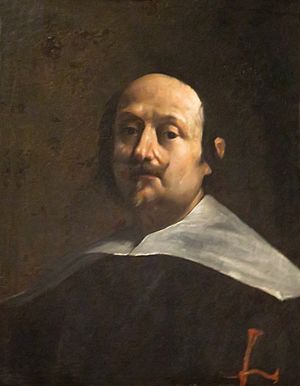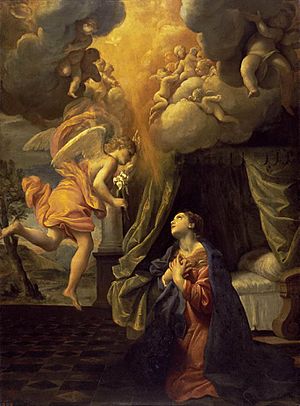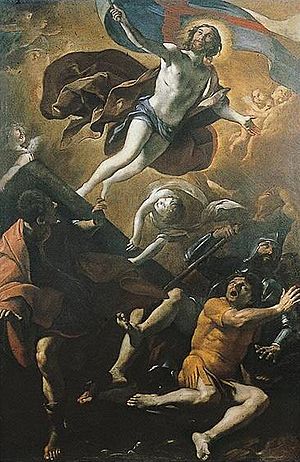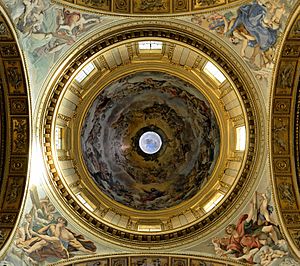Giovanni Lanfranco facts for kids
Quick facts for kids
Giovanni Lanfranco
|
|
|---|---|

Self-portrait, between 1628 and 1632
|
|
| Born | 26 January 1582 Parma, Italy
|
| Died | 30 November 1647 (aged 65) Rome, Italy
|
| Nationality | Italian |
| Known for | Painting |
| Movement | Baroque |
Giovanni Lanfranco (born January 26, 1582 – died November 30, 1647) was a talented Italian painter. He was a key artist during the Baroque period, known for his dramatic and colorful paintings.
Contents
Early Life and Training
Giovanni Gaspare Lanfranco was born in Parma, Italy. He was the third son of Stefano and Cornelia Lanfranchi. From a young age, he showed a gift for drawing. This talent led him to become an apprentice. He trained with the Bolognese artist Agostino Carracci. Agostino was the brother of the famous painter Annibale Carracci. Giovanni worked alongside another artist from Parma, Sisto Badalocchio. They painted in the Farnese palaces in their hometown.
When Agostino Carracci passed away in 1602, Giovanni moved to Rome. He joined Annibale Carracci's large and important art studio. At that time, Annibale's studio was busy decorating the famous Galleria Farnese. This gallery is located in the Palazzo Farnese. Giovanni helped paint the Polyphemus and Galatea panel. He also worked on other smaller pieces in the room. After this, Giovanni continued to work with the Carracci studio. He helped paint frescoes in the Herrera Chapel. This chapel is part of San Giacomo degli Spagnoli (1602–1607). He also contributed to the decorations of San Gregorio Magno and the Cappella Paolina in Santa Maria Maggiore.
Becoming an Independent Artist

By 1605, Giovanni Lanfranco started getting his own art jobs. For example, he painted for the Camerino degli Eremiti. This was a small building next to the church of Santa Maria dell’Orazione e Morte. Cardinal Odoardo Farnese built this special room. Many artists contributed to its paintings and frescoes. Lanfranco's work for this series included the unique Translation of the Magdalen.
After Annibale Carracci died in 1609, Giovanni returned to Parma. He stayed there for two years. During this time, he met Bartolomeo Schedoni. He also painted an altarpiece for the Ognissanti church. Lanfranco also created paintings and altarpieces in other Italian towns. These included Orvieto, Vallerano, Leonessa, and Fermo.
Return to Rome and Major Works
Giovanni Lanfranco came back to Rome by 1612. He began to compete for painting jobs. Other students of Carracci, like Guido Reni and Domenichino, were also seeking work. Reni soon left Rome, but Lanfranco and Domenichino became rivals. They competed for the most important fresco commissions. Lanfranco even accused Domenichino of copying another artist's work.
Unlike Domenichino, Lanfranco was flexible in his painting style. He often chose a dramatic and imaginative approach. This style was perfect for the large ceiling paintings popular in the 1600s. His art showed influences from Ludovico Carracci. Ludovico was a cousin of Agostino and Annibale. Lanfranco also seemed inspired by Caravaggio in some works. For example, his altarpiece Inspiration of Saint Luke (1611) shows this. In other paintings, he used the style of Antonio Correggio. An example is his Adoration of the Shepherds.
Lanfranco's art studio became very busy. They painted frescoes in the Palazzo Mattei. They also decorated the Buongiovanni Chapel in Sant'Agostino (1616). This chapel features a painting called Assumption. His Annunciation (1615) in San Carlo ai Catinari is considered one of his best works. Soon, Lanfranco became a favorite painter of Pope Paul V. He painted frescoes for the Palazzo Costaguti. He also created a large ceiling fresco at the Villa Borghese. This painting is called The Gods of Olympus or Council of the Gods.
In the next year, Lanfranco worked with Agostino Tassi and Carlo Saraceni. They decorated the Sala de' Corazzieri and Sala Regia. These rooms are in the Palazzo del Quirinale. His formal Presentation at the Temple shows a bright, Carracci-like style. In 1622, he painted the Ecstasy of Saint Margaret of Cortona. This was an altarpiece for Santa Maria Nuova in Cortona. This painting might have inspired the famous St Theresa in ecstasy by Bernini. From 1623 to 1624, he decorated the Sacchetti Chapel. This chapel is in San Giovanni dei Fiorentini in Rome.
Even though the next Pope, Gregory XV, preferred other artists, Lanfranco still got important jobs. He painted for the Crucifix Chapel in Santa Maria in Vallicella. However, his greatest work is the Assumption of the Virgin fresco. This huge painting covers the dome of Sant'Andrea della Valle. He finished it in 1627. The painting uses a special perspective called sotto in su. This makes the figures look like they are floating above you. The bright colors and energy make it a landmark in Baroque painting. Lanfranco was inspired by Correggio's dome decoration in the Duomo di Parma.
Urban VIII asked Lanfranco to paint a large fresco. It showed St. Peter Walking on Waters (1628). For this work, Lanfranco was given the title of Knight of the Order of Christ. In 1631, he became the Prince (leader) of the Academy of Saint Luke. This was the main artists' group in Rome. There is also a fresco by Giovanni Lanfranco above the monument of Pope Clement VIII in Santa Maria Maggiore.
From 1634 to 1646, Lanfranco worked in Naples. He decorated the dome and other parts of the Jesuit church of the Gesù Nuovo. This was from 1634 to 1637. Then, from 1637 to 1638, he painted frescoes in the nave and choir of the Certosa of San Martino. After that, he decorated Santi Apostoli from 1638 to 1646. He also painted the dome of the Cappella of San Gennaro in the Cathedral of Naples. These works greatly influenced Neapolitan painters of the late 1600s. These artists included Preti, Giordano, and Solimena. Giovanni Lanfranco passed away in Rome in 1647. His last work was the apse of San Carlo ai Catinari.
Artistic Style and Influence
Lanfranco was a very flexible and diverse artist. He learned from the Carracci family and continued their style. He added a dramatic flair to his paintings. This was different from the more controlled style of Domenichino. Lanfranco explored new ways of painting. He combined older traditions with newer ones. He used both Mannerist and Baroque styles. He also used a dark, shadowy style called tenebrism. At the same time, he used a rich, colorful palette. One of his students was Giacinto Brandi.
Notable Artworks
- Venus plays the Harp, Galleria Nazionale d'Arte Antica, Rome (Palazzo Barberini)
- Alexander tended by the doctor and Alexander refusing water to drink from his men
- The Annunciation (c. 1615–1624) San Carlo ai Catinari, Rome
- Coronation of the Virgin with St. Augustine and St. William of Aquitaine
- Hagar in the Wilderness (Louvre)
- Liberation of Saint Peter (c. 1620–21), Birmingham Museum of Art, Alabama
- Palazzo Quirinale frescoes
Images for kids
-
Annunciation, between 1610 and 1630 (Hermitage Museum)
See also
 In Spanish: Giovanni Lanfranco para niños
In Spanish: Giovanni Lanfranco para niños







